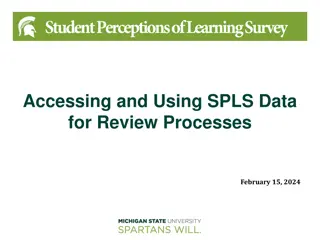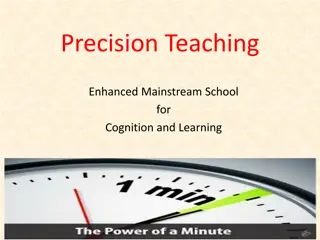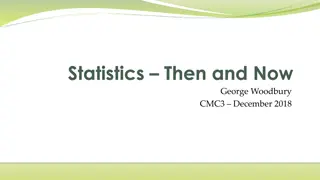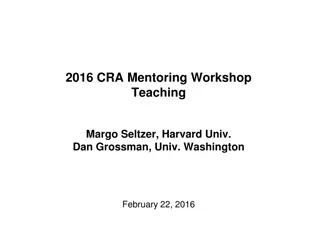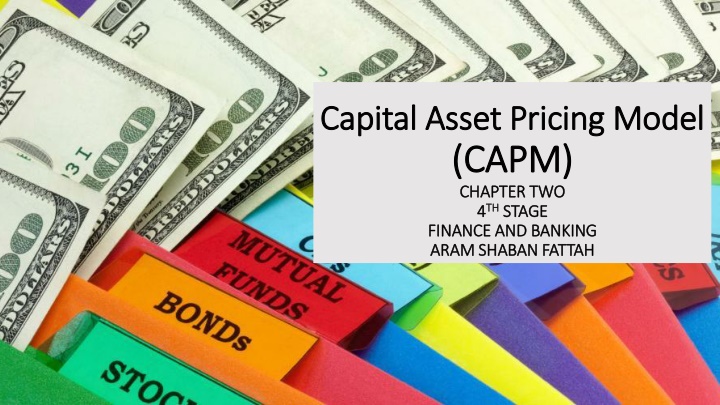
Capital Asset Pricing Model (CAPM) in Finance
Explore the Capital Asset Pricing Model (CAPM) in finance, its limitations, development, and meaning. Learn how to calculate required returns for investments with different betas and discover key assumptions of CAPM.
Download Presentation

Please find below an Image/Link to download the presentation.
The content on the website is provided AS IS for your information and personal use only. It may not be sold, licensed, or shared on other websites without obtaining consent from the author. If you encounter any issues during the download, it is possible that the publisher has removed the file from their server.
You are allowed to download the files provided on this website for personal or commercial use, subject to the condition that they are used lawfully. All files are the property of their respective owners.
The content on the website is provided AS IS for your information and personal use only. It may not be sold, licensed, or shared on other websites without obtaining consent from the author.
E N D
Presentation Transcript
Capital Asset Pricing Model Capital Asset Pricing Model (CAPM) (CAPM) CHAPTER TWO CHAPTER TWO 4 4TH STAGE FINANCE AND BANKING FINANCE AND BANKING ARAM SHABAN FATTAH ARAM SHABAN FATTAH THSTAGE
Limitations of Harry Markowitz Model: Limitations of Harry Markowitz Model: 1. Only risky securities taken for investment. 2. It requires large amount of input data. An investor must obtain estimates of return, variance of return and covariance of returns for each pair of securities included in the portfolio. For ex. If there are N number of securities in the portfolio, then N estimates of return, variances and (N2-N)/2 estimates of covariances are required. For ex. For 4 securities (42-4)/2 i.e. 6 covariances are estimated and for 10 securities (102-10)/2 i.e. 45 covariances are estimated.
Capital Asset Pricing Model (CAPM) Capital Asset Pricing Model (CAPM) Development Development The capital asset pricing model, or CAPM, was developed by Lintner, and Mossin in the early 1960s, and further refined later. The model predicts the relationship between the risk expected returns on risky assets. A model that relates the required rate of return on a security to its systematic risk as measured by beta. CAPM is an extended Markowitz Model. Treynor, Sharpe, and equilibrium version of
Capital Asset Pricing Model (CAPM) Capital Asset Pricing Model (CAPM) meaning! meaning! Capital-asset pricing model (CAPM) A model that describes the relationship between risk and expected (required) return; in this model, a security s expected (required) return is the risk-free rate plus a premium based on the systematic risk of the security. In the CAPM theory, the required rate return (expected return) of a security is having a linear relationship with security s beta value i.e. undiversifiable or systematic risk.
Suppose the risk free rate of return is 5%, and the expected market return is 10%. What return will a diversified investor require from investments with betas of 0, 0.5, 1, and 1.5? Again, the formula is: rp= rf+ (rm rf) so: if = 0 rp= 5% + 0 (10% 5%) = 5% if = 0.5 rp= 5% + 0.5 (10% 5%) = 7.5% if = 1 rp= 5% + 1 (10% 5%) = 10.0% if = 1.5 rp= 5% + 1.5 (10% 5%) = 12.5% Where the beta = 1 the expected return of the investment is equal to the expected return on the market, and the higher the beta coefficient, the higher the expected return
(CAPM) ASSUMPTIONS: (CAPM) ASSUMPTIONS: 1. The investors are basically risk averse and diversification is needed to reduce the risk. 2. All investors want to maximize the return and choose a portfolio solely on the basis of risk and return assessment. 3. All investors can borrow or lend an unlimited amount of funds at risk-free rate of interest (risk-free lending and risk-free borrowing). 4. All investors have same estimates of risk and return of all securities. 5. All securities are perfectly divisible and liquid and there is no transaction cost or tax. 6. There is a perfect competition in the market. There are many investors, and no single investor can affect the price of a stock through his or her buying and selling decisions. 7. All investor are efficiently diversified and have eliminated the unsystematic risk. Thus, only the systematic risk is relevant in determining the estimated return.
Capital Asset Pricing Model (CAPM) Capital Asset Pricing Model (CAPM) meaning! meaning! The total CAPM Model explained under two broad segments: I. Capital Market Line (CML) II. Security Market Line (SML)
I. Capital Market Line (CML) I. Capital Market Line (CML) The Capital Market Line (CML) is a straight line that begins at the risk-free rate and ends at the highest possible expected return for any given risk level. The line shows the required expected return for every possible level of risk and the risk-return ratio (the slope) is determined by the market portfolio. The CML line tells us what portfolios investors will choose to hold efficient portfolios. The portfolios on the CML optimize the risk and return relationship. This maximizes the performance. The slope CML is the Sharpe Ratio of the market portfolio. It is usually said that one should buy assets if the Sharpe ratio is above the CML and sell if the same is below the CML.
I. Capital Market Line (CML) I. Capital Market Line (CML)
What is Sharpe Ratio? Sharpe Ratio measures returns with respect to the risk taken. The returns can be both negative and positive. A higher Sharpe ratio means, a higher return without too much risk. Thus, while Investing, investors should choose a security (stock,bond etc.) that shows a higher Sharpe ratio.
II. SECURITY MARKET LINE (SML) II. SECURITY MARKET LINE (SML) The security market line (SML) is a visual representation of the capital asset pricing model (CAPM). SML reflects the linear relationship between a security s expected return and beta, i.e. its systematic risk. The security market line (SML) can also be used to determine whether an asset is overpriced or underpriced, given its level of systematic risk, compared to the market.
USING THE SECURITY MARKET LINE (SML) USING THE SECURITY MARKET LINE (SML) The security market line is commonly used by money managers and investors to evaluate an investment product that they're thinking of including in a portfolio. The SML is useful in determining whether the security offers a favorable expected return compared to its level of risk. The SML is frequently used in comparing two similar securities that offer approximately the same return, in order to determine which of them involves the least amount of inherent market risk relative to the expected return. The SML can also be used to compare securities of equal risk to see which one offers the highest expected return against that level of risk.
II. SECURITY MARKET LINE (SML) II. SECURITY MARKET LINE (SML) When a security is plotted on the SML chart, if it appears above the SML, it is considered undervalued because the position on the chart indicates that the security offers a greater return against its inherent risk. Conversely, if the security plots below the SML, it is considered overvalued in price because the expected return does not overcome the inherent risk.
Capital Market Line vs. Security Market Line The SML is derived from the CML. CML SML Shows the rates of return for a specific portfolio. Represents the market s risk and return at a given time, and shows the expected returns of individual assets. The measure of risk in the CML is the standard deviation of returns (total risk) The risk measure in the SML is systematic risk or beta.


